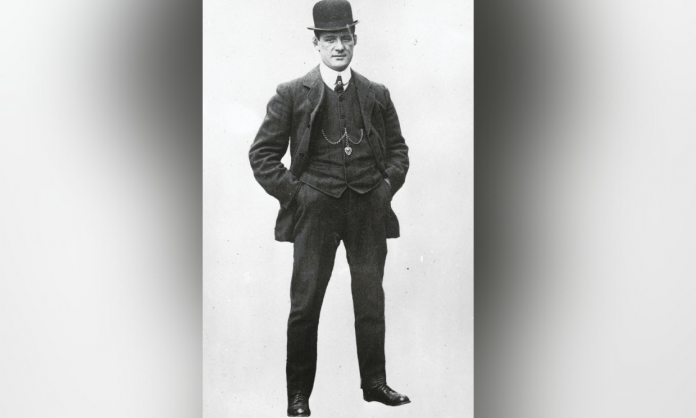The great Irish-Welsh Featherweight Boxer
by Martin Gleeson
Little Ireland
After the Great Famine thousands of Irish people, many from Co.Cork, travelled to Cardiff, then a very busy port. They sailed on the coal boats which were used to bring coal from Wales to Ireland. Hundreds of these poor Irish people settled in an area of Cardiff called Newtown. There they lived in crowded houses with poor sanitation. The locals were very hostile to this influx of poverty-stricken diseased Irish emigrants.
There were so many Irish people living in Newtown that it was called Little Ireland.
James (Jim) Driscoll was born in Ellen Street, in Newtown. Jim’s father, Cornelius Driscoll had left Co. Cork with his parents not long after the Famine. He married an Irish girl, Elizabeth, and they had five children.
Cornelius worked in the local dockyards and tragically he was killed in a work accident when Jim was only seven months old, leaving Elizabeth to bring up the children. She supported them by taking in lodgers and doing cleaning work on the ships.
As staunch Catholics, St. Paul’s Church was a key part of the Driscolls’ family life.
Also, the Nazareth House Orphanage in Cardiff was so dear to Jim’s heart that many years later he made a huge sacrifice to keep a promise he had made to the nuns who ran the orphanage.
Bully
When Jim was only eleven years old, he got a job as a Printer’s Devil in the Western Mail printing works. Jim’s elder brother Flurrie and his sister Mary Ann were being bullied and constantly attacked by a seventeen-year-old neighbour called Big Dennis. Jim decided to stop the bully and they had a confrontation. It ended with Big Dennis being carried to hospital and eleven-year-old Jim suffering only from slight bruising and swollen knuckles.
Amateur Boxing
When Jim was only 12, he visited the Leckwith Fair, mainly to see the traveling boxing booths. A prize was offered to anyone who could last sixty seconds with upcoming fighter Badger O’Brien. Jim won the award, and this encouraged him to become an amateur boxer.
When Jim was 17, he joined a team of boxers managed by Jack Scarrott. His first fight in Tonypandy was against a Welsh boxer called Shoni Engineer who had over 400 fights to his credit. In the second round Jim knocked him out. Shoni’s Welsh supporters were dismayed while Jim’s Irish supporters were thrilled.
Jim spent four years traveling mostly in Wales to fairground booths taking on all comers and fighting with great success in about 600 competitions.
Then, in 1901 at the age of 21, Jim turned professional.
Professional Boxing
Jim won his first professional fight against Billy Lucas by decision. Within three years Jim hat 14 wins, 10 of them knockouts and four by decisions. In February 1906 Jim defeated Joe Bowker in a 15-round contest in the National Sporting Club in Covent Garden and became the British Featherweight Champion. He undertook four more fights before he defeated Bowker a second time to retain the title.
In 1908 Jim defeated New Zealander Charlie Griffin and won the Commonwealth Featherweight title.
USA
As Jim was both the British and Commonwealth featherweight champion, the United States of America beckoned and he sailed to New York in 1908. He was now a married man but he had to leave his new wife Edith behind. His first fight was very soon after he arrived in the Bronx, New York, he defeated Matty Baldwin.
Jim fought Featherweight champion Abe Attell in 1910 and dominated the match. However, in those days a boxer needed a knockout to claim the crown. Bat Masterson, the famous gunfighter from Dodge City, declared to the crowd: ”If I was asked to name Jim’s performance here tonight I would call it peerless. So I give you Peerless Jim Driscoll.” Thus, Jim had attained the nickname Peerless Jim which stuck with him all his life.
He was offered a rematch and a payment of $ 1,000 but he declined it because he had committed himself to play a charity bout in aid of his favourite charity at home, the Nazareth House Orphanage back in Cardiff. He told his friends: “I never break a promise.” But for this selfless decision he most likely would have been crowned World Featherweight Champion.
Jim returned to Wales to do the charity bout and the Nazareth House Orphanage event took in £ 6,000, a huge sum in those days.
Jim never forgot his roots among the Irish in Newtown. He often bought shoes for the children on the streets and at Christmas time bought food to provide Christmas dinners for the people with whom he had grown up.
War
When World War I broke out, Jim enlisted in the Welsh Horse Yeomanry. He was given the rank of Company Sergeant Major and was a Physical Training Instructor in France where he gave short boxing exhibitions for the troops. It is estimated that he gave 12,000 of these exhibitions.
Failing Health
Jim had suffered for years from chest infections. After the war he returned for three more fights. He had purchased the public house named The Duke of Edinburgh in Cardiff. This bar was noted for helping those who had been wounded in World War I. However, on 30th January 1925 in his bar in Ellen Street, Cardiff, where he grew up, Jim became ill and died of pneumonia at the age of44.
Over 100,000 admirers of Jim from both the Welsh and Irish communities lined the streets of Cardiff for his funeral.
In 1997 a statue of Jim Driscoll was erected in his honour near the Central Boys’ Club where he trained as a youngster.








